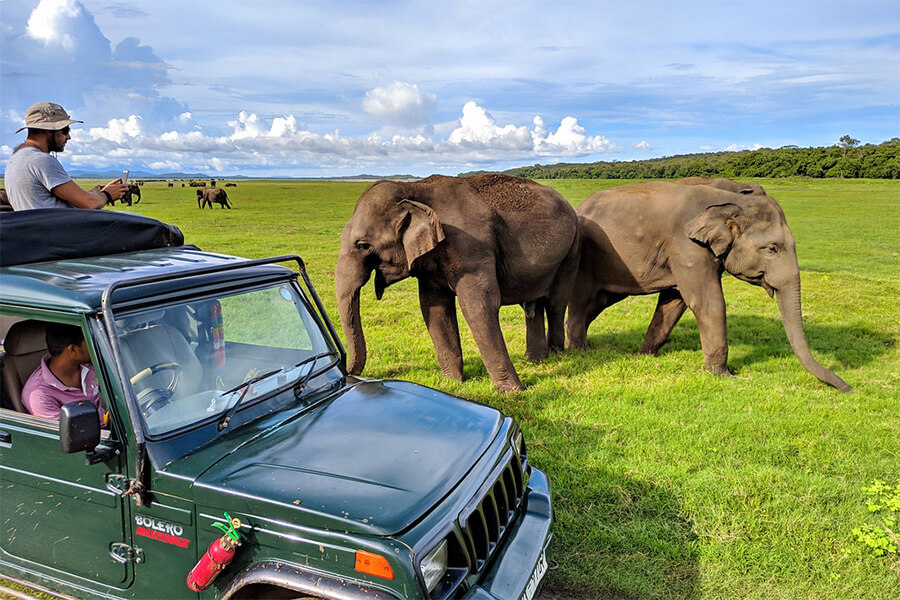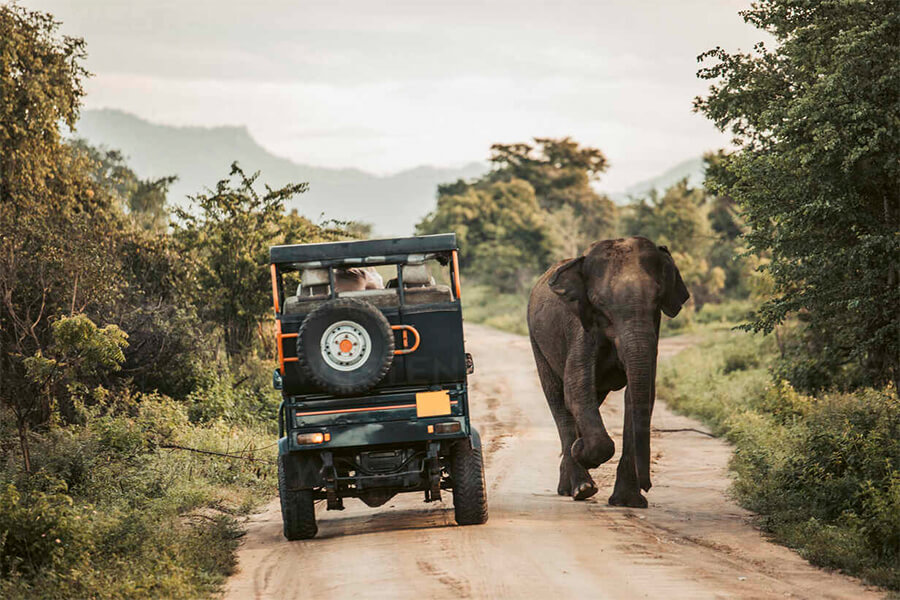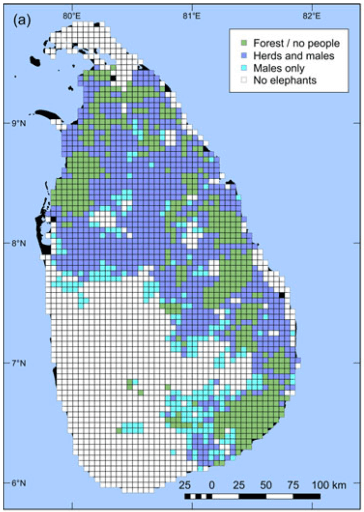For many travelers, nothing feels more magical than watching wild elephants move silently through the misty grasslands, or crossing a dirt track right in front of your jeep. Among all wildlife experiences in Asia, seeing local tours in Sri Lanka and especially seeing elephants in Sri Lanka is one of the most accessible and rewarding. The island is home to one of the largest Asian elephant populations in the world, and with careful planning you can see Sri Lanka elephants in their natural habitats, from dry-zone scrub forests to shimmering reservoirs and open plains. In this guide, we’ll explore the top 4 places to see elephants in Sri Lanka, how to choose between them, and how to observe every Sri Lanka elephant encounter responsibly.
Where to See Elephants in Sri Lanka
When planning a trip focused on elephants in Sri Lanka, most travelers think of the “Cultural Triangle” and the southern national parks. The good news is that you can see Sri Lanka elephants in both regions, often in combination with cultural sightseeing and beach time. Below are four of the most reliable and rewarding places to see elephants in Sri Lanka in the wild, each offering slightly different landscapes and experiences.
Yala National Park - Sri Lanka Elephants
Yala National Park is perhaps the most famous wildlife destination in the country. While it is best known for its high density of leopards, it is also a superb place to see elephants in Sri Lanka in a classic safari setting. Sandy tracks wind through scrub forest, rocky outcrops, and lagoons where waterbirds gather alongside grazing Sri Lanka elephants.
Because Yala is relatively dry, the remaining waterholes and tanks become magnets for wildlife, especially in the dry season. It’s common to see a Sri Lanka elephant or small family group emerge from the bush to drink or bathe, often right at sunset when the light turns golden. Sharing a moment of silence as an elephant in Sri Lanka flaps its ears, sprays itself with mud, or nudges a youngster closer to the shade is unforgettable.
From an experience standpoint, Yala is ideal if you want a “big safari feel” with the possibility of seeing leopards, sloth bears, crocodiles, and Sri Lanka elephants in one day. However, it is also one of the busiest parks, so:
- Book morning and afternoon game drives with reputable operators who respect wildlife.
- Avoid pressuring your driver to “chase” sightings; let the elephants in Sri Lanka move freely.
- Consider visiting during shoulder seasons when there are fewer vehicles.
Practical tip: Choose a lodge slightly outside the main gate area, where you may even see a Sri Lanka elephant wandering near the property or along rural roads at dawn and dusk.
Kaudulla National Park - The Migrating Herds of Elephant in Sri Lanka
Located in the Cultural Triangle, Kaudulla National Park is closely linked with nearby Minneriya, and together they host one of the most spectacular gatherings of elephants in Sri Lanka. The highlight here is watching large herds spread out across grasslands near the reservoir, often in the late afternoon light, with dozens of Sri Lanka elephants visible at once.
Kaudulla is especially attractive as an alternative to Minneriya on days when the herds have shifted due to water levels and grass availability. Local guides track these movements closely and can advise whether Kaudulla or Minneriya is better for elephants in Sri Lanka during your travel dates. On the right day, you might see mothers, calves, and juveniles all feeding together near the water’s edge, plus lone bulls watching curiously from the side.
A typical jeep safari in Kaudulla involves:
- Entering the park in mid-afternoon.
- Driving through low forest and scrub where you may first spot a solitary elephant in Sri Lanka.
- Emerging onto open grasslands with panoramic views of the reservoir and herds of Sri Lanka elephants.
Because the elephants are truly wild and free-ranging, your guide will keep a respectful distance. You’ll have time to watch them interact, play, and feed, rather than rushing from sighting to sighting. This slower, more observational style of travel lets you appreciate the social behavior of elephants in Sri Lanka, such as trunk touches, trumpeting, and playful mock charges among youngsters.
Practical tip: Combine Kaudulla with cultural visits to Sigiriya and Polonnaruwa. Many travelers plan a morning at a heritage site, followed by a late-afternoon safari focusing entirely on Sri Lanka elephants.
Minneriya National Park - The Great Gathering of Elephants in Sri Lanka
Minneriya National Park is world-famous for “The Gathering” – a seasonal congregation of wild elephants in Sri Lanka that has been called one of the greatest wildlife spectacles in Asia. During the dry season (typically from July to around October, depending on rainfall), hundreds of Sri Lanka elephants move toward the Minneriya Tank, an ancient reservoir whose receding waters create lush grasslands.
In the late afternoon, jeeps position themselves at a distance, engines switched off, as family groups gradually appear over the horizon. One by one, more and more elephants in Sri Lanka join the scene: mothers guiding tiny calves, teenagers playing, bulls keeping an eye on rival males. The scale can be astonishing, and seeing such a concentration of Sri Lanka elephants in one place is a powerful reminder of the island’s natural heritage.
What makes Minneriya special is not just the numbers, but the behavior you can witness when you give yourself time:
- Young Sri Lanka elephants learning to use their trunks, clumsily splashing water or grabbing grass.
- Protective females forming a shield around newborn calves.
- Subtle body language among adult elephants in Sri Lanka indicating comfort, dominance, or curiosity.
Respecting the animals is crucial here. Work with ethical safari providers who:
- Keep jeeps at a safe distance instead of crowding the herds.
- Avoid driving between groups of Sri Lanka elephants.
- Follow park rules about noise, speed, and off-road driving.
Practical tip: If you’re visiting the Cultural Triangle and your priority is seeing as many elephants in Sri Lanka as possible, schedule at least two or three nights, so you can adjust between Minneriya and Kaudulla based on real-time elephant movements.
Udawalawe National Park - Year-Round Elephants in Sri Lanka
Udawalawe National Park is often described as one of the best places in Asia for reliably seeing wild elephants in Sri Lanka at any time of year. The combination of open grasslands, scattered trees, and the large Udawalawe Reservoir makes it particularly scenic, and the visibility is excellent – you can often see Sri Lanka elephants from a long distance as they move across the plains.
Unlike parks that are strongly seasonal, Udawalawe offers very high chances of sightings on almost every safari. It is common to see multiple family groups, bachelor herds, and even solitary bulls in a single drive. Many travelers choose Udawalawe specifically to maximize their opportunities to observe elephants in Sri Lanka in a calm, open environment.
Highlights of a typical Udawalawe safari include:
- Watching a Sri Lanka elephant family bathing together in a shallow pool, calves sandwiched between adults.
- Seeing elephants walk along the skyline at sunrise or sunset with the reservoir in the background.
- Observing interactions between wild Sri Lanka elephants and other species like buffalo, spotted deer, and a variety of birds.
Udawalawe is also home to an elephant transit home just outside the park boundaries, where orphaned juvenile Sri Lanka elephants are rehabilitated and gradually prepared for release back into the wild. You can observe feeding times from a designated viewing platform, which can be a meaningful complement to your in-park safari.
Practical tip: Udawalawe works very well in combination with the southern beaches. You can travel from Udawalawe to destinations like Mirissa, Tangalle, or the Galle area in a few hours, blending elephants in Sri Lanka with coastal relaxation.
Spotting Wild Elephants in Sri Lanka: North or South Sri Lanka?
A common question when planning a wildlife itinerary is whether it’s better to see elephants in Sri Lanka in the north/central region or in the south. Both offer excellent opportunities, but they differ in landscape, travel flow, and overall experience.
Central & North-Central Sri Lanka - Cultural Triangle + Elephants in Sri Lanka
In the Cultural Triangle (around Sigiriya, Dambulla, and Polonnaruwa), your main elephants in Sri Lanka destinations are Minneriya and Kaudulla. This region is ideal if you:
- Want to combine heritage sites with wildlife in a compact area.
- Are traveling in the dry season when The Gathering of elephants in Sri Lanka is most likely.
- Prefer the sight of large herds spread out across open grasslands, especially at sunset.
Here, cultural sightseeing and wildlife safaris fit naturally into the same itinerary: you might climb Sigiriya Rock Fortress in the morning, then join an afternoon safari focused on Sri Lanka elephants. Families, first-time visitors, and travelers with limited time often find this combination very convenient.
Southern Sri Lanka - Classic Safaris and Coastal Routes with Elephants in Sri Lanka
In the south, Yala and Udawalawe are your key parks for elephants in Sri Lanka. This region is a great choice if you:
- Want a classic multi-day safari feel with diverse wildlife, including leopards and crocodiles.
- Are planning to spend time on southern beaches such as Mirissa or Tangalle.
- Prefer more open, dry landscapes where spotting a Sri Lanka elephant from a distance is easier.
Yala delivers a sense of drama and variety – one moment you might be scanning for leopards, and the next watching a solitary elephant in Sri Lanka emerge from the bush to cross a track. Udawalawe is calmer but extremely reliable for repeated elephants in Sri Lanka sightings.
How to Choose Between North and South for Elephants in Sri Lanka
To decide whether to focus on the north/central area or the south, consider:
- Time of year: If traveling during the peak of The Gathering, the Cultural Triangle parks can offer dense herds of elephants in Sri Lanka. At other times, Udawalawe may be more consistent.
- Trip length: With a week or less, it may be easier to focus on one region. With more time, you can combine both and enjoy multiple styles of Sri Lanka elephant encounters.
- Other interests: Culture and ancient cities point you north; beaches and coastal towns point you south.
In reality, there is no single “best” region. Many seasoned travelers return to see elephants in Sri Lanka multiple times in different parks, each visit revealing new behaviors, landscapes, and photo opportunities.
Responsible and Respectful Encounters with Elephants in Sri Lanka
Regardless of where you go, how you behave matters. Ethical tourism is crucial to protecting elephants in Sri Lanka and ensuring that local communities benefit from their presence.
Here are some key principles:
- Prioritize wild over captive experiences: Focus on national parks and sanctuaries where Sri Lanka elephants roam freely. Avoid venues that offer elephant rides, performances, or unnatural tricks.
- Keep a safe distance: Allow elephants in Sri Lanka to choose how close they come. A zoom lens and patience are better than pressuring your driver to approach too closely.
- Stay quiet: Loud voices and sudden movements can stress a Sri Lanka elephant, especially mothers with young calves.
- Support responsible operators: Choose guides and lodges with a clear commitment to conservation and community support, not just sightseeing.
By following these guidelines, you contribute to a model of tourism that values the well-being of every elephant in Sri Lanka, not just the photo opportunities.
Making the Most of Sri Lanka Elephant Encounters
Planning a journey centered on elephants in Sri Lanka is about more than ticking a species off your list – it’s about connecting with the landscapes, communities, and conservation efforts that make these encounters possible. Whether you’re watching a lone Sri Lanka elephant walking along a dusty track in Yala, witnessing the mass Gathering in Minneriya, tracking herds across Kaudulla’s grasslands, or observing playful calves in Udawalawe, each moment offers insight into the complex world of these intelligent animals.
To design a meaningful itinerary, consider combining:
- One Cultural Triangle park (Minneriya or Kaudulla) for large herds of elephants in Sri Lanka near cultural sites.
- One southern park (Yala or Udawalawe) for classic safari scenery and a different style of Sri Lanka elephant viewing.
- Time with knowledgeable guides, who can explain elephant behavior, local challenges, and how tourism helps protect Sri Lanka elephants.
With thoughtful planning and the right mindset, your trip will not only give you beautiful memories of elephants in Sri Lanka, but also help ensure that future travelers can enjoy the same privilege – watching wild Sri Lanka elephants roam their ancestral lands, just as they have for generations.






